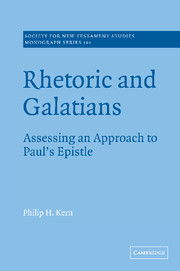Book contents
- Frontmatter
- Contents
- Preface
- List of abbreviations
- 1 Introduction
- 2 Towards a definition of rhetoric
- 3 Methods of rhetorical analysis and Galatians
- 4 Rhetorical structure and Galatians
- 5 Rhetorical species and Galatians
- 6 The language of Paul's letters: 1. As evaluated by early Christian writers
- 7 The language of Paul's letters: 2. The contribution of modern studies
- 8 Conclusions
- Select bibliography
- Index of subjects
- Index of modern authors
- Society for New Testament Studies
4 - Rhetorical structure and Galatians
Published online by Cambridge University Press: 22 September 2009
- Frontmatter
- Contents
- Preface
- List of abbreviations
- 1 Introduction
- 2 Towards a definition of rhetoric
- 3 Methods of rhetorical analysis and Galatians
- 4 Rhetorical structure and Galatians
- 5 Rhetorical species and Galatians
- 6 The language of Paul's letters: 1. As evaluated by early Christian writers
- 7 The language of Paul's letters: 2. The contribution of modern studies
- 8 Conclusions
- Select bibliography
- Index of subjects
- Index of modern authors
- Society for New Testament Studies
Summary
It has become practically axiomatic since the appearance of Hans Dieter Betz's Hermeneia commentary that study of the argument and structure of Galatians begins with classical rhetoric. Betz's assertions that ‘The body of [Galatians] is constructed as a defense speech using argumentative, judicial rhetoric’, and that, as a result, ‘Paul's letter to the Galatians can be analyzed according to Graeco-Roman rhetoric and epistolography’, have exerted great force even upon those who do not share his convictions concerning the overall purpose of Galatians.
C. K. Barrett is typical when he suggests that while ‘Paul conformed a little less closely than Dr Betz suggests to the contemporary models of courtroom and similar speeches … on the whole the parallels are convincing’. He adds that Betz's ‘analysis, and the parallels that he draws, are illuminating’, evincing the ‘methods and skills of the professional orator’.
Although Barrett questions details of Betz's reconstruction, main premises (including some we will question) are accepted. At issue are nothing less than the purpose and function of Galatians. This chapter compares the shape of Galatians with structural guideposts provided by the handbooks – primarily those cited in Betz's commentary, interacting chiefly with Betz because he has articulated a defence of a thorough and original rhetorical analysis of the epistle's structure; those disagreeing on the species of Galatians (see chapter 5) have not grappled with the details to the extent that Betz has.
- Type
- Chapter
- Information
- Rhetoric and GalatiansAssessing an Approach to Paul's Epistle, pp. 90 - 119Publisher: Cambridge University PressPrint publication year: 1998



